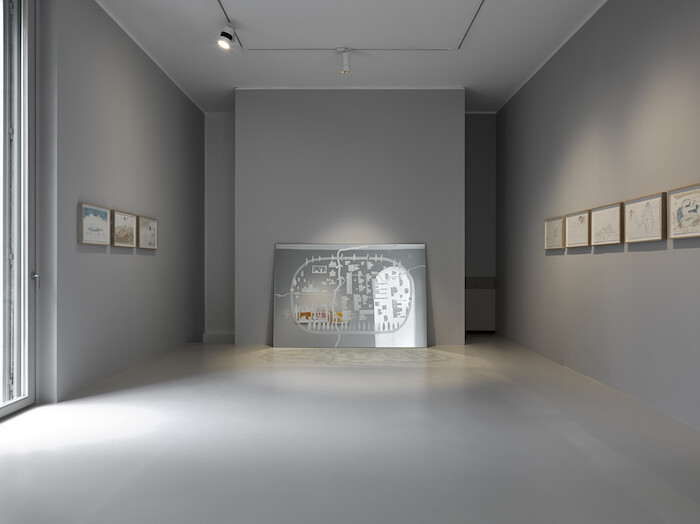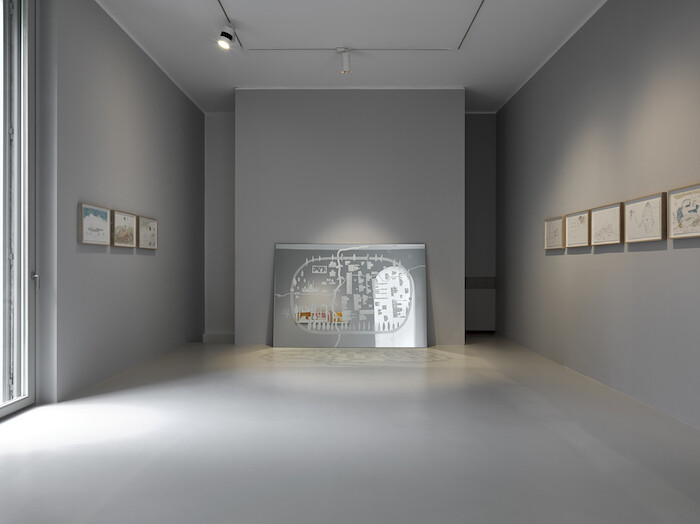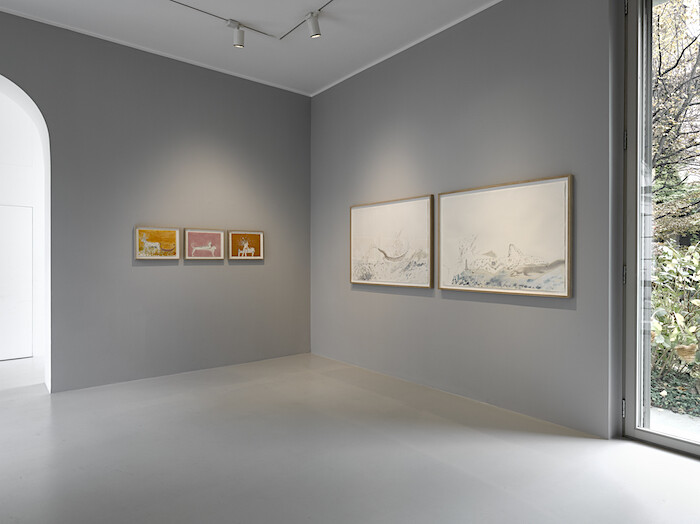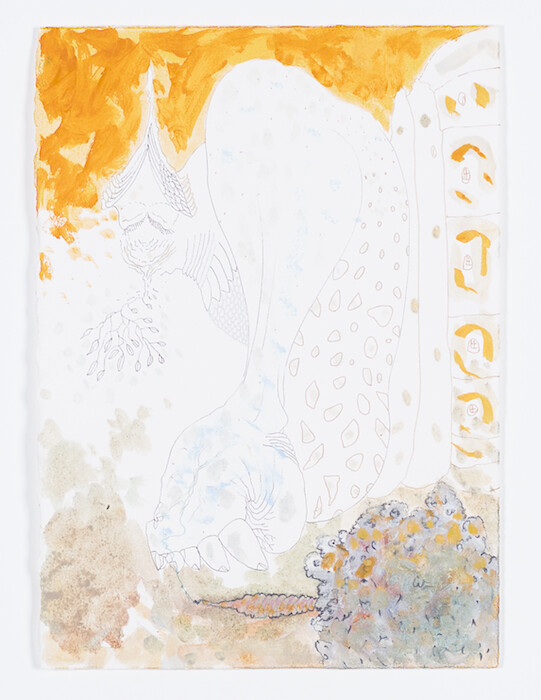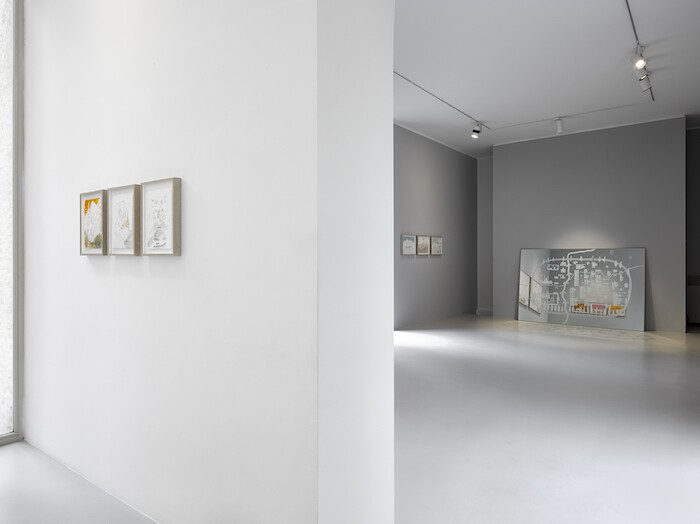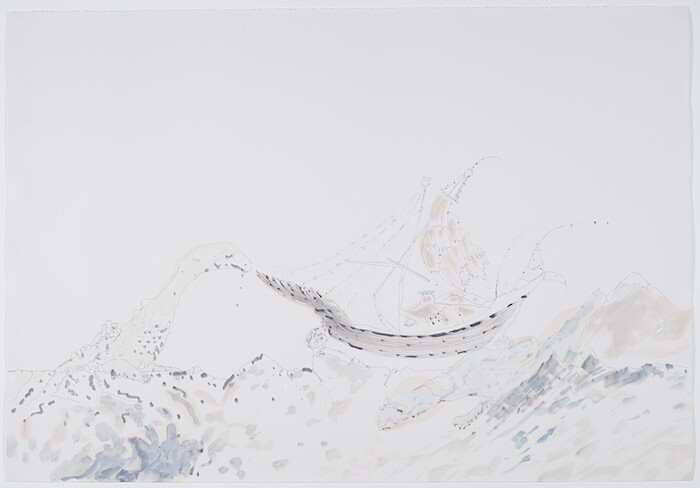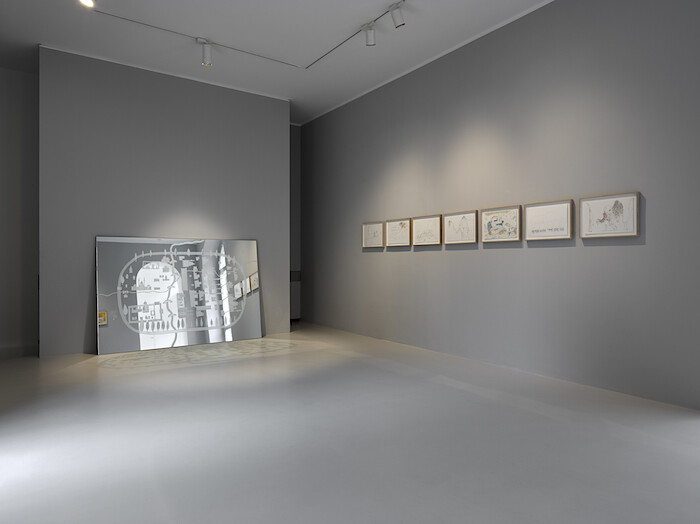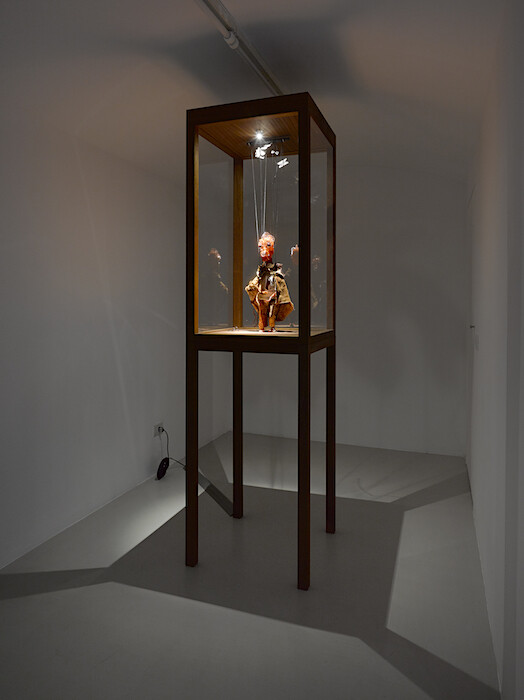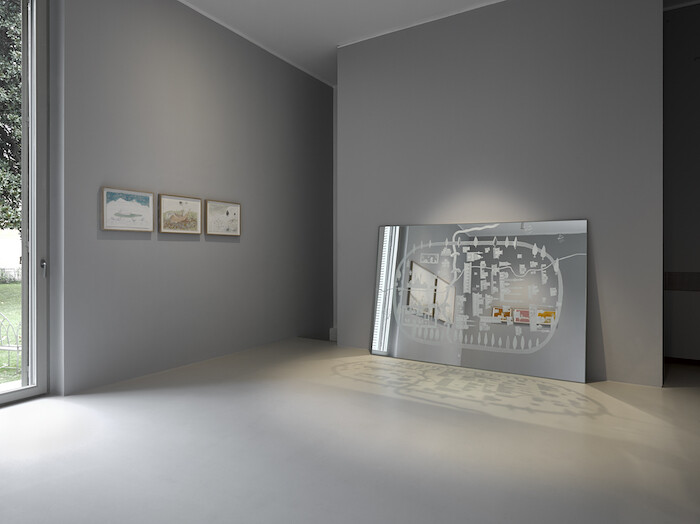Craggy peaks of stone, desolate plains, parched and rasping arctic coasts—still caught perhaps in some distant geologic era—provide a home to stray beasts of all kinds: the spindly heads of snakes rise like pinnacles from the summits of crumbling towers. The sagging legs of pachyderms prop up arcades redolent of Byzantium. The hooked beaks of hawks frown from the prows of merchant vessels. Prehistoric herbivores with dorsal crests like minarets spring from the ground, breaking its crust as if they had just awoken from centuries of hibernation. The salt spume curls into the outline of a feather, of a scale. Stone turns to visage, snout, and sneer.
Pinned down by tremulous lines of ink and graphite, and filled with the pale colors of a sorbet—blush, ocher, powder blue—the drawings of surreal vistas (about 20 in all, with the collective title Al Araba Al Madfuna Drawings, 2015) that underpin Wael Shawky’s first show at Lisson Gallery’s Milan venue tell of a world straddling past and present, East and West, with the penchant for zoomorphism found in ancient civilizations, first and foremost that of Egypt, the artist’s home country. Docile creatures parade through them, alarming no one. The doubtful perspective skews planes and shrivels up distances. There is no trace of humankind, save its existential wreckage.
Like scraps of fabric from an ample cloak, these drawings seem plucked from the fringes of “Al Araba Al Madfuna” (2012-2016), a trilogy of films presented within an installation of yellow-and-blue scenic elements reminiscent of the Middle East at Fondazione Merz in Turin in parallel to the show at Lisson. The beauty of this series (named after a village near Abydos, Egypt, where myth and ordinary life seem to overlap) primarily derives from the sense of unreality pervading the stories it tells, which are drawn from Dayrout al-Shareif (1983), a collection of parables by Egyptian writer Mohamed Mustagab. It is as if Shawky had rewritten these tales in the sand with the aid of a bamboo stick.
The first film tells of a tribe called Al Jabarina who, in order to win the favor of heaven, must welcome an animal into its community. In the second, a village falls silent, and a famous enchantress condemns her bridegrooms to a terrible fate. In the third (the most disorienting, because unlike the first two in black-and-white, it is in inverted color, like a photographic negative), a sunflower becomes a symbol of palingenesis. Tone and settings are the stuff of fable, but the cast is even more fanciful: schoolboys in turbans, jellabiyas, and fake moustaches act the part of grown men, undercutting the drama, and moving everything in the direction of an out-and-out flight from reality.
In the show at Lisson Gallery, the childhood of both man and civilization is evoked by two works connected to the film trilogy “Cabinet Crusades” (2010-2015), which can instead be seen at a concurrent retrospective at the Castello di Rivoli Museo d’Arte Contemporanea, Turin. Accompanying the drawings, propped against the wall, is a reflective panel with a mappa mundi above it—the primitive kind, with all the buildings (domes and minarets) laid out flat, the way a child would draw them (Cabinet Crusades Map 3, 2015). And, in a showcase, a marionette (Cabaret Crusades III: The Secrets of Karbalaa [Marionette], 2014); its strings call to mind how the puppeteer emerges after the show to thank the audience, standing tall amid his puppets, which we suddenly see for what they are: wood and rags, tools in the hands of their maker.
“Cabinet Crusades” presents stories of ecstasy and transfiguration and martyrdom and suffering, imbued with contrasting echoes. They take us far, far back, to the Crusades, though seen this time from an Eastern standpoint (with Europeans as the aggressors, Arabs as the oppressed): an idea inspired by reading The Crusades through Arab Eyes (1984) by Lebanese writer Amin Maalouf. Here the land is made fertile by human blood, such is the slaughter and death, yet there is no sense of horror, because the actors are not people but rather a troupe of puppets (wood, ceramic, and glass)—awkward and faltering in their movements, some with the heads of camels or horses—and the landscape is a painted backdrop.
With one eye on the present, Wael Shawky fishes in the millpond of history. His spear captures its grand episodes and tiny details, the ways it is passed down, muffled, obscured. He does away with all naturalism, identification, drama—all reality. He restages it, but with “miniature” men. It becomes not moralizing, but poetic. In the works on view at Lisson, the harsh sting, sour aftertaste, or blatant lesson of the original sources lose their bite, become figurative. And suddenly the fishing pond turns into something else; it vanishes into a space that is too large, pours out into the river or the open sea, and we are lost in it.
